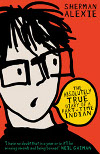The absolutely true diary of a part-time Indian by Sherman Alexie

Anderson Press, 2008. ISBN 9781842708445
Highly
Recommended. Humour
belies the undercurrent of poverty and despair tugging at the heels of
the
diarist, Arnold, as he tries to alter the accepted path for boys like
him. He
enrolls at a more academic school, twenty miles from his homeland. That
the
school is a white middle class institution in a town where Arnold and
his
people from the nearby Spokane Indian Reservation are not wanted makes
for some
cutting and deft observations about racism. Drawing heavily on his
background,
Sherman Alexie is able to nimbly circumvent political correctness and
tell it
like it is.
Arnold's
teacher gives out the geometry books on the first day of high school.
Arnold is
keen to get stuck into this new subject, and when he opens the book to
find it
was used by his mother, 30 years before, he knows that he will never
break out
of the mold. Opportunities given to Indigenous kids are just not there.
At the
nearby white school, he finds himself the only Indian student in a sea
of white
faces. The customs at his last school must be unlearned, his culture
put behind
him and his loyalties divided between the two worlds he inhabits. Some
people
on the 'rez' avoid him, his best friend deserts him, but some are
proud, and
his uncle calls him a warrior for doing something so brave.
In
different hands this book could have been cheesy and even insulting,
but
Alexie's intimate knowledge of the reservation makes this a uniquely
powerful
read. The story cries out for recognition of the Indian plight. Moved
to
reservations with little opportunity for employment or activities, poor
education and blighted by racism, Arnold speaks for his generation. The
path he
chooses is burdened with pitfalls however, in having to live a divided
life,
being seen as a traitor on one hand, and a curiosity on the other.
The
debate over indigenous people writing their own stories flourishes,
none more
vocal than the website hosted by Debbie Reese in USA. She applauds the
writing of indigenous
people, particularly American Indians, and deplores the writing of non
indigenous writers using an indigenous point of view. Her views are
widely used
and her website
often quoted. The
recent issue of Fiction Focus, an
adolescent fiction journal from the Western
Australia Education Department, outlines some of the current debate
about
indigenous writers writing their own stories, in an article called
Whose
Story? Indigenous Peoples in Fiction, and gives
information
about some
of the books written by indigenous writers, including the excellent,
The Absolutely True Diary of a Part-Time
Indian by Sherman Alexie.To
find out more about Sherman Alexie's background, go to http://www.fallsapart.com/. And
to find out about the
reservation he
grew up on, visit, the
official
website for
the Spokane Tribe in Washington.
Studying
this novel in the classroom would be a knockout for lower secondary
kids. It
will turn their faces to the reality of living in an indigenous
community
whether in Australia or USA or New Zealand. Stories written by other
indigenous
authors could be studied, and some written by non indigenous authors
could be
looked at to compare the tone. As part of a unit of study about racism
or
prejudice or specifically North American Indians, this novel has all
points
covered. I would expect that many schools will buy this as a class set.
Fran Knight